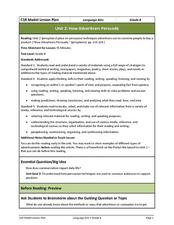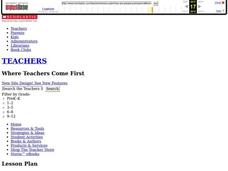EduGAINs
Coureurs de Bois, First Nation Peoples, and the Fur Trade
The interactions between the Coureurs de bois (runners of the woods) and the First Nation Peoples as they engaged in the fur trade are the focus on this Canadian history exercise. Kids select learning centers based on their learning...
Do2Learn
Respecting the Ideas of Others
Communicating clearly is one part of a successful conversation, but listening to others is just as important. Individuals with special needs plan calm responses and reactions to differing opinions with a collaborative activity.
Curated OER
Tomb Robbers
Sixth graders examine benchmark angles embedded into a circle grid and examine how grid systems do not always have to be square. the game "Tomb Robbers" is used to develop strategies.
Curated OER
Confusable Letter Pairs
Students practice distinguishing between pairs of similar-looking lowercase letters, such as b and d, p and b, m and w, n and m. They distinguish between easily-confused letter pairs by reading and listening to a story that highlights...
Education World
Thinking About Thanksgiving: Lessons Across the Curriculum
Bring two integrated curriculum resources about Thanksgiving to an elementary social studies unit. The first activity focuses on Squanto's contributions to the early Pilgrims' survival with a gardening activity in which learners add fish...
Curated OER
Self Acceptance
Sixth graders brainstorm their strengths and the positive qualities that make them unique. They write their own short story in prose.
Curated OER
Showdown on the Frontier
Especially critical following a series of shootings in schools, theaters, and religious buildings, it's safe to say that we need to evaluate the current laws on gun control. Eighth graders read a New York Times article in order to better...
National Endowment for the Humanities
Mark Twain and American Humor
“The Celebrated Jumping Frog of Calaveras County” is famous, in part, because it established a uniquely American form of humor. For this famous story, Mark Twain combines the tall-tale, the dialect story, and satire. Here is a resource...
Curated OER
Come Fly with Me . . . Open a Book: Travels through Literature
This detailed overview of a curriculum unit suggests using travel literature to engage and stimulate your third graders’ interest in reading. The suggested reading list includes fiction and non-fiction materials and offers urban children...
Foreign Policy Research Institute
Exploring Korea
A thorough and fun lesson on Korea! In groups of four (Social Chair, Historian, Translator, Travel Agent) class members research North and South Korea to determine a good location for an overseas institute for studying abroad. Once this...
Curated OER
Cross-Cultural Dialogue Lesson
Use the Peace Corps to explore a different place and different perspectives. Your class reads the personal narrative "Cross-Cultural Dialogue" by Roz Wollmering, completing an attached story frame sheet in preparation for a class...
Curated OER
Sculpture in Balance
Learners discuss the difference betwen two-dimensional vs. three-dimensional art. In this art lesson, students discuss what symmetry or balance is in art and construct a symmetrical and an asymmetrical mobile.
Berkeley Engineering and Mentors
Marshmallow Catapaults
After a brief lecture on levers, torque, projectiles, and the five-step engineering design cycle, young physical science learners or engineers build catapults out of craft sticks. This is an open-ended exploration of what works and what...
Curated OER
How Advertisers Persuade
This plan centers around the article "How Advertisers Persuade," although it is not included in the instructional activity itself. Get your class thinking about advertising, appeals, and techniques that companies use to get their...
Curated OER
Ghosts of Rwanda: Reconciliation and Reparations
Students examine a specific case of genocide participation in Rwanda. Working in groups, they simulate the courtroom drama, from the positions of victim, perpetrator, and court monitor. They conclude by writing essays on the...
Curated OER
About the Author: Kate DiCamillo
Learners examine the writing process of Kate DiCamillo, the author of "Because of Winn-Dixie." They read author's comments, watch a slideshow narrated by the author, complete a free-write activity, and discuss Kate DiCamillo's top five...
Curated OER
A Picture Is Worth a Thousand Words
Students, after reading the book, "Esperanza Rising," create a virtual display by combining different story elements into a visual representation. They choose the setting and characters of a scene that will act as a springboard of ideas...
Curated OER
Log Canoes: A Chesapeake Bay Tradition
In this reading comprehension worksheet, students read a story about log canoes on the Chesapeake Bay and examine the dialogue between characters. Students use the dialogue between the characters to answer five short answer questions.
EngageNY
The Painted Essay for Opinion Writing: The Introductory Paragraph
The answer is blowin' in the wind. Using the resource, scholars read and analyze a model essay about wind power. Next, they work in groups to write an introductory paragraph that expresses an opinion about the topic.
Curated OER
Doctor DeSoto's Foxy Persuasion
Who is Doctor DeSoto? Start by playing a video clip (included). Discuss different methods of persuasion, and then analyze two different persuasive letter examples. What should your class be looking for? Send them off to work in groups...
Curated OER
How are People Portrayed by Different Media?
Your 9th - 12th graders can hone their analysis and critical thinking skills by studying the way a subject is portrayed across media types. They examine how various print, visual, and online sources have portrayed key players in the 9/11...
Curated OER
Homophobia: What is It? What Can We Do About It?
A two-part lesson focuses on the sensitive issues of homophobia, discrimination, sexuality, and gender. Middle schoolers discuss individual and institutional discrimination, personal rights, homosexuality, and bullying.
EngageNY
Speech Writing: Identifying Criteria for a High-Quality Introduction
Using a helpful resource, pupils watch a TED Talk of an opinion speech as they consider the criteria for a high-quality introduction. Scholars then engage in a shared writing process with the teacher to practice writing the introduction...
EngageNY
Speech Writing: Identifying Criteria for a High Quality Conclusion
Learning is never-ending. Scholars learn about effective conclusions as they continue watching a video of an opinion speech. After analyzing the speech's conclusion, they work in small groups to write an ending for their own speeches.

























